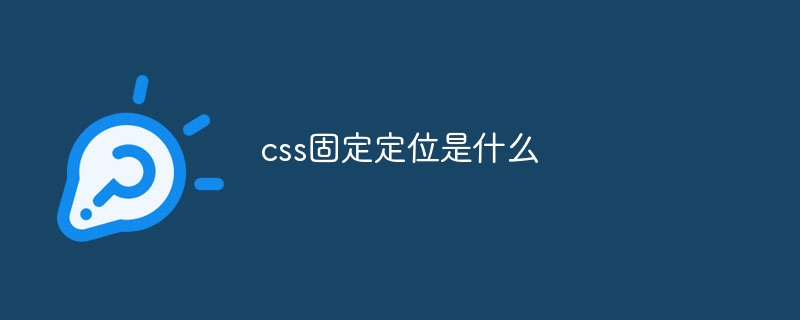Home >Web Front-end >Front-end Q&A >What is css fixed positioning
What is css fixed positioning
- 百草Original
- 2023-10-25 17:06:271890browse
Fixed positioning in CSS is a layout technology that is achieved by setting the "position" attribute of an element to "fixed". Fixed-positioned elements are positioned relative to the viewport, not relative to their parent elements. or other elements, which means that a fixed positioning element will remain in a fixed position in the viewport no matter how the user scrolls the page. Fixed positioning requires attention to compatibility, mobile devices, performance impact, etc. Fixed positioning is widely used in scenarios such as navigation bars, advertising banners, return to top buttons, and floating toolbars.

The operating system for this tutorial: Windows 10 system, DELL G3 computer.
Fixed positioning (Fixed positioning) in CSS is a layout technology that makes elements have a fixed position relative to the viewport and does not change as the page scrolls. Fixed positioned elements will always remain at a specific location on the screen, no matter how the user scrolls the page. In this article, I will introduce the concept, usage and some considerations of fixed positioning in detail.
1. The concept of fixed positioning:
Fixed positioning is a positioning method in CSS, which is achieved by setting the `position` attribute of the element to `fixed`. Fixed positioned elements are positioned relative to the viewport, not relative to their parent or other elements. This means that fixedly positioned elements will remain in a fixed position in the viewport no matter how the user scrolls the page.
2. Usage of fixed positioning:
To use fixed positioning, we need to follow the following steps:
1. Set the `position` attribute of the element to `fixed`:
In CSS, we can use `position: fixed` to set the element to a fixed position. This way, the element will have fixed positioning properties.
2. Set the positioning value of the element:
We can use the `top`, `right`, `bottom` and `left` attributes to set the positioning value of the element on the viewport. By adjusting the values of these properties, we can control the exact position of the element in the viewport.
3. Set positioning restrictions:
Fixed positioned elements will be positioned relative to the viewport, but we can also set `top`, `right`, `bottom` and `left `The value of the attribute to limit the movement range of the element. For example, we can set `top: 0` and `right: 0` to anchor the element to the top right corner of the viewport.
It should be noted that fixedly positioned elements will break away from the normal document flow and will not affect other elements. This means that other elements will ignore fixedly positioned elements, and overlapping elements may occur. To avoid this, we can use the `z-index` attribute to control the stacking order of elements.
3. Precautions for fixed positioning:
When using fixed positioning, there are several precautions that we need to pay attention to:
1. Compatibility:
Fixed positioning is well supported in modern browsers, but there may be compatibility issues in some older versions of browsers. When using fixed positioning, we should conduct compatibility testing and provide alternatives or fallback styles as needed.
2. Mobile devices:
On mobile devices, fixedly positioned elements may cover the content of the page, resulting in a poor user experience. To solve this problem, we can use media queries and responsive design to provide different styles or layouts for mobile devices.
3. Performance impact:
Fixed positioned elements may have a certain impact on the performance of the page, especially when dealing with a large number of fixed positioned elements. To improve performance, we should avoid overuse of fixed positioning and minimize the number of fixed positioning elements.
4. Application scenarios of fixed positioning:
Fixed positioning has many practical application scenarios in Web development, such as:
1. Navigation bar:
We can use fixed positioning for the navigation bar of the website so that it always remains at the top or bottom of the page to facilitate user navigation.
2. Advertising banner:
When inserting an advertising banner into a website, we can use fixed positioning to fix it at a specific location on the page to increase the exposure of the advertisement.
3. Return to top button:
In order to facilitate users to return to the top of the page, we can use fixed positioning to fix the return to top button in the corner of the page, making it visible at any time.
4. Floating toolbar:
In some applications or blogs, we can use fixed positioning to fix the toolbar at the top or bottom of the page so that users can use the tool at any time.
Summary:
Fixed positioning is a CSS layout technology. By setting the `position` attribute of the element to `fixed`, the element has a fixed position relative to the viewport and does not change as the page scrolls. . When using fixed positioning, we need to set the positioning value of the element and pay attention to some compatibility, mobile device and performance issues. Fixed positioning is widely used in scenarios such as navigation bars, advertising banners, return to top buttons, and floating toolbars.
The above is the detailed content of What is css fixed positioning. For more information, please follow other related articles on the PHP Chinese website!

